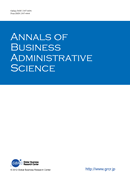All issues

Volume 13 (2014)
- Issue 6 Pages 299-
- Issue 5 Pages 243-
- Issue 4 Pages 183-
- Issue 3 Pages 129-
- Issue 2 Pages 67-
- Issue 1 Pages 1-
Volume 13, Issue 2
Displaying 1-4 of 4 articles from this issue
- |<
- <
- 1
- >
- >|
-
Nobuo TAKAHASHI, Nobuyuki INAMIZU2014Volume 13Issue 2 Pages 67-76
Published: April 15, 2014
Released on J-STAGE: April 15, 2014
JOURNAL OPEN ACCESSThe present paper identifies leaps in the logic of Granovetter's (1973) “The Strength of Weak Ties.” Granovetter states that “bridges” are “weak ties” due to the existence of a “forbidden triad.” However, the latter portion of his work, which cites empirical evidence, indicates a reversal in the logical relationship, stating that “weak ties” are “bridges.” Granovetter also provides very little evidence to state definitively that “forbidden triads never happen.”View full abstractDownload PDF (251K) -
Four Prerequisites of Competitive AdvantageMizuki KOBAYASHI2014Volume 13Issue 2 Pages 77-90
Published: April 15, 2014
Released on J-STAGE: April 15, 2014
JOURNAL OPEN ACCESSDyer and Singh (1998) use the dyad or network, rather than the single firm, as their unit of analysis, and suggest a relational view (RV), which considers interfirm competitive advantage. However, when discussing competitive advantage from the perspective of RV, one must be aware that the special case of Toyota and its suppliers is the assumption. Even in comparison with other Japanese automakers, Toyota and its suppliers have certain characteristics, such as: a) they are geographically close to each other; b) they have substantive special assets; and c) they proactively share knowledge via human interaction, and have a systematic inter-organizational learning system to support this knowledge sharing. Thus, firms trying to acquire competitive advantage of RV need to meet the above prerequisites. Further, RV discussions advocating an increase in special assets for long-term transactional advantage rely on d) product features. If one assumes a less-complex product such as a personal computer, with frequently changing transaction partners where short-term transactions are insignificant, the effectiveness of RV cannot be guaranteed. Given these considerations, this paper summarizes the characteristics a) through d) as prerequisites that generate competitive advantage, from the perspective of RV.View full abstractDownload PDF (238K) -
Takeaki WADA, Takeyasu ICHIKOHJI, Fumihiko IKUINE2014Volume 13Issue 2 Pages 91-103
Published: April 15, 2014
Released on J-STAGE: April 15, 2014
JOURNAL OPEN ACCESSPorter (1998) noted that with continuing global homogenization in companies' condition to obtain resources and gain access to markets, there is an increasing need to create a local, competitive advantage in industrial clusters. He called the importance of location in this age of globalization a “location paradox.” Similarly, when industry-wide platforms appear and global development technologies are standardized, companies need to accumulate unique technical capabilities to differentiate themselves. In this paper, this phenomenon is known as the “platform paradox,” and is verified by a case of videogame industry. The utilization of development platforms (game engines and middleware) standard within this industry during the 2000s, causing global homogenization in development technology. Videogame development companies' industrial cluster located in Japan's city of Fukuoka cooperated in technological matters in an effort to differentiate themselves with their technological sophistication in using platforms. By aggressively sharing knowledge to optimally utilize hardware and development tools, these companies have created a store of unique technologies.View full abstractDownload PDF (246K) -
A Case of Microsoft JapanNobuyuki INAMIZU2014Volume 13Issue 2 Pages 105-127
Published: April 15, 2014
Released on J-STAGE: April 15, 2014
JOURNAL OPEN ACCESSNon-territorial offices are regarded as having two benefits: 1) efficient use of space and 2) stimulating communication. It is noted that those aiming for successful non-territorial offices must focus on office density. This study discusses four indicators related to office density. Using these indicators, this study analyzes the case of an office move of Microsoft Japan. This study demonstrates that (i) the implementation of a non-territorial office that focused on the ratio of the number of employees present to the number of seats entirely failed, and while (ii) Microsoft's management focused on the ratio of the number of employees to the number of seats during implementation, regarding stimulating communication at the post implementation phase, the focus was on the ratio of the number of employees present to office area, where they met success.View full abstractDownload PDF (869K)
- |<
- <
- 1
- >
- >|